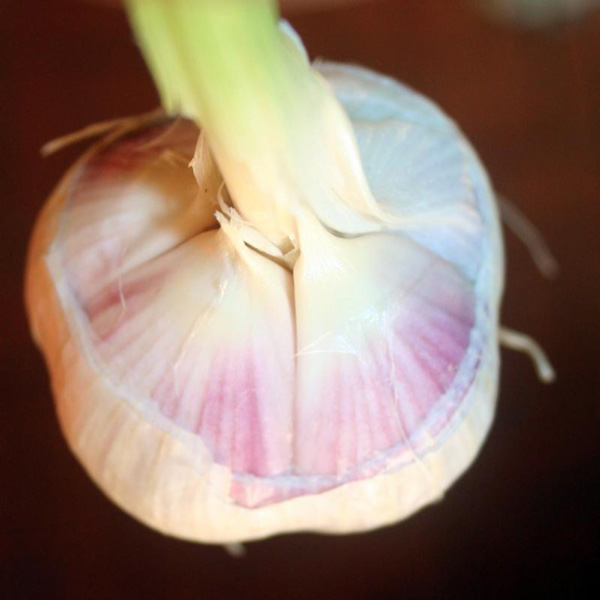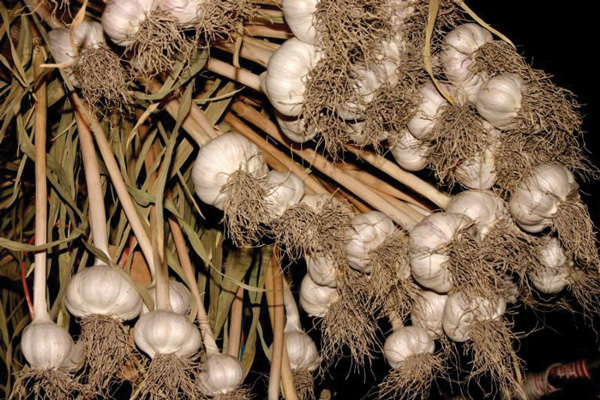News & Articles
Browse all content by date.


Garlic is an outlier among garden plants. It marches to its own drum beat, doing the proverbial zig while its peers zag en masse like a school of fish. A member of the lily family of bulb plants, garlic is planted in fall and harvested the following summer. And what is planted isn’t a seed, technically, but a miniature plant, also known as a clove, AKA the thing you cook with. Each clove will develop into an entire head of garlic with DNA identical to its own. Thus, when you grow garlic, you are actually growing parallel genetic lineages, side by side. A spicy tribe of clones.
Dedicated growers of the fragrant lily will always be surrounded by the fruits of their labor. At any time of year, plants are either in the ground, or bulbs are being stored indoors, or both. In spring, when everybody else is looking at their sad, brown patches of bare dirt, garlic growers can be seen basking in the green glow of their lush new foliage, thanks to the head start their garlic plants got from being planted, basically, now.
In addition to planting the garlic, and the related task of tucking it in for the winter, garlic cultivation entails many other tasks before, during and after harvest that would take more than a column’s worth of explaining to convey. Since now is time for planting, I’ll focus there for today. For the rest of the year, and for some timeless wisdom and provocative social commentary to boot, the book Growing Great Garlic by Ron Engeland belongs on your shelf.
The planting window lasts from the end of summer until the ground freezes. What you need is some cloves to plant, a place to plant them, and some mulch with which to cover them.
There are numerous specialty outlets that will ship exotic strains of garlic to you, but you’ll pay premium prices for what is, in every respect, just plain garlic. And when it comes to finding a strain that grows well in your region, there is no better tell, or source of seed, than your local farmers. Through years of trial and error they have identified the kinds of garlic that grow in your home ground, and they have the proof on display at the farmers market. So decide which farmer has the garlic you like best, buy some, and plant it.
As you dig around and prep your patch, you’ll no doubt savor the unlikely contrast of planting the garden while autumn leaves swirl about. Hopefully not flakes of winter snow, for that matter, but I’ve snuck in a garlic crop later than I should have-close to Thanksgiving-and gotten away with it. As you dig, add and mix in compost, peat moss, or any other conditioners you think your soil could use.
If you want to grow enough garlic to eat to your heart’s content all year long, and still have enough left over to plant, you need to know three things: how much garlic that is, which garlic you wish to plant, and my proprietary equation: x = z/(y-1).
Also known as the pinnacle of my applied mathematics career, this equation is designed to solve for the number of bulbs one needs to plant in order to satisfy one’s garlic needs. We will call this number “x.”
To solve for x, we need to know y, which represents the average number of cloves per bulb in your variety of garlic, and z, the number of harvested bulbs you want to eat in a year. I use a strain of Romanian Red that averages about five cloves per bulb, so in my case Y = 5. I want to have a bulb per day, so I can have plenty for eating, trading, and giving away to aspiring garlic growers. So z = 365.
Solving for x we get 91.25, which I round up to 92 bulbs of garlic. If we run the numbers backward to double-check, we start with 92 bulbs at five cloves per bulb, or 460 cloves planted. If I harvest 460 bulbs, and subtract the 365 bulbs I intend to eat, I’m left with 95 bulbs for planting next year. The extra three bulbs, a bonus, are the result of my rounding up from 91.25.
Buying that many bulbs could cost you a couple hundred bucks, but if you buy wisely, and take care of the generations of parallel clones, it could be the last money you ever spend on garlic.
When you have the garlic you intend to plant, gingerly break apart each bulb and separate the cloves, leaving as much paper on as possible. Take extra care not to break off the scabby plates at the bottom of each clove, which will become the nexus of roots for the young plant. The clove is planted root plate-down, pushed deep enough that there is about an inch of space between the upper tip of the clove and the soil surface. Plant the cloves at least six inches apart.
Now comes a crucial part of the garlic planting process: covering the patch with mulch. Be it in the form of straw, leaves or compost, mulch performs a multitude of jobs to keep your garlic happy and healthy. It insulates the garlic through the winter, lessening the chance the cloves will freeze to death, and keeps the earth warmer, for better root proliferation. In spring, the mulch will suppress weeds and help the soil retain moisture as it breaks down, releasing nutrients that feed the soil and, in turn, the young garlic plants.
For these reasons and others, mulching is a pursuit that Engeland, the garlic guru, pursues “with the dedication of a champion chess player, and the fervent sincerity of a young priest.”
Straw is nice to use, as long as you don’t end up with hay by mistake-hay is cut later, and is full of seeds that will sprout in your patch. I use the fallen leaves of autumn, because they are free, beautiful and full of minerals and organic matter. Leaves that have been shredded are ideal; they break down much quicker, and allow the young garlic shoots through, while un-shredded leaves will form a tough mat that young garlic shoots often can’t penetrate. If you don’t have a shredder, make a pile of leaves run over it with your lawnmower until the leaves are sufficiently chopped.
At this point you’ve earned a warm cup of tea. Sip it by the hearth, as you peruse Engeland’s book. Or flip through your seed catalogs, as you ponder what to do with the rest of next year’s garden.
| Tweet |


